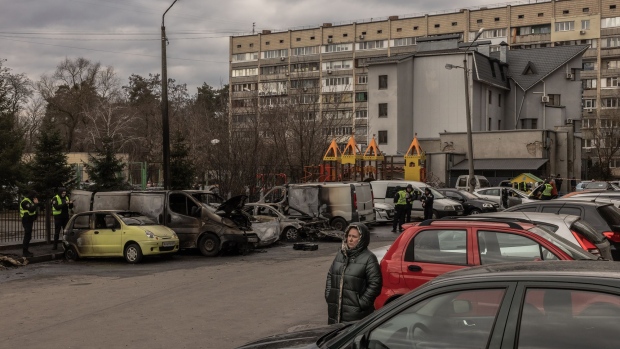Mar 9, 2023
Ukrainian Cities Hit by New Wave of Russian Missile Attacks
, Bloomberg News

(Bloomberg) -- Russia launched a devastating bombardment against cities across Ukraine, killing at least five people and casting hundreds of thousands into sporadic blackouts with a new mix of weapons that mostly evaded air defenses.
The strike was unusual in the number of expensive, high-end missiles used, raising the difficult to answer question of why Russian planners decided to deploy them in such numbers now.
Ukraine said it shot down 34 of the 81 missiles fired, a lower than usual proportion because the barrage included three classes of weapon against which it has no defense.
They included six Kinzhals, which military analysts assess to be a version of the nuclear-capable Iskander ballistic missile adapted for launch from an aircraft. This was the largest number of Kinzhals that Russia has used in a single air strike to date.
In addition to the Kinzhals, six KH-22 anti-ship missiles and 13 S-300 anti-aircraft missiles adapted for use against land targets also got through, according to Ukraine’s Air Force.
“Russian forces used the array of missiles, especially those that Ukraine cannot intercept such as the Kinzhal, to ensure that they have some informational successes as a result of this missile campaign regardless of the dwindling supply of high-precision missiles,” said Kateryna Stepanenko, a Russia research analyst at the Institute for the Study of War, a Washington think tank that closely tracks the war.
Growing Ukrainian success in shooting down Moscow’s cruise missiles had fed criticism of the war effort inside Russia from nationalist military bloggers and some TV personalities, who portrayed the winter missile strike campaign to freeze Ukrainians into surrender as a failure, Stepanenko said.
The Russian Ministry of Defense described the March 9 missile campaign as a retaliatory strike for a cross border incursion into Russia’s Bryansk region on March 2.
The attack extended Russian Vladimir Putin’s five-month campaign of air strikes targeting civilian infrastructure including the energy grid, hospitals, schools and residential buildings.
Kremlin forces are currently storming Ukrainian fortifications in the city of Bakhmut, prompting President Volodymyr Zelenskiy to call for reinforcements to prevent Russia from gaining an “open road” to capture more territory in Ukraine’s eastern Donbas region.
“The enemy fired 81 missiles in an attempt to intimidate Ukrainians again, returning to their miserable tactics,” Zelenskiy said on Telegram. “The occupiers can only terrorize civilians.”
At one meter in diameter and eight meters long, the Kinzhal travels at high speeds and carries a destructive 480 kilogram (1,058 pound) payload, making it a fearsome weapon that was likely developed to target ships and command centers in the event of conflict with the North Atlantic Treaty Organization.
“It’s difficult to intercept because it’s launched at long-range, it’s fast, (above Mach 5 at peak speed), it’s likely capable of mid-course maneuvers like the 9K720 Iskander (RS-SS-26 Stone) of which it’s a variant, and it flies at altitudes that have tended to be neglected by ground based air defenses,” said Douglas Barrie, senior fellow for military aerospace at the International Institute for Strategic Studies, a London think tank.
How many Russia has to use in Ukraine is unknown and the fact that six were deployed in a single attack tells us little, according to Barrie. Ruslan Pukhov, head of the Centre for Analysis of Strategies and Technologies in Moscow, said it’s possible Russia used the Kinzhals because it’s saving its dwindling stock cruise missiles shot from ground-based launchers for what’s expected to be more intense fighting with the end of winter.
“Russia had to expand the use of Kinzhal missiles because Ukraine’s air defense capabilities improved and will improve further as they will receive more Western air defense systems,” Pukhov said. “In the wake of more active fighting this spring it is more logical to use Kinzhals now and save more cruise missiles for future.”
While Ukraine’s authorities say the electricity grid has survived the most difficult period of winter, low temperatures continue to test millions of Ukrainians left vulnerable from the war. The capital and major cities such as Kharkiv, Odesa and Zhytomyr reported blackouts, while air-raid sirens that started blaring after midnight continued to sound as the sun rose.
The barrage underscored the wide-scale destruction Putin’s forces are wreaking on Ukraine with the war in its second year. Tens of thousands of people have died in Russia’s attempt to seize control of its neighbor — and until recently historical ally — while the fighting has driven more than a third of Ukraine’s 41 million people from their homes.
With the most intense combat now centered around Bakhmut, Ukrainian Foreign Minister Dmytro Kuleba said Kyiv’s forces would hold the line “until it becomes impossible,” Italian newspaper La Repubblica reported.
“If we can still fight in Bakhmut, we must fight,” Kuleba said in an interview published on Thursday.
Air defenses shot down all the missiles and drones that targeted the capital, but missiles struck their targets elsewhere. Ukraine shot down only 34 of the 81 fired during the bombardment and only half of the eight drones launched at targets outside of Kyiv, the commander-in-chief of Ukraine’s armed forces, Valeriy Zaluzhnyi, said on Telegram.
“The attack was truly massive,” Ukrainian Air Defense spokesman Yuriy Ihnat said on television.
Worst Is Over in Russia’s War on Ukrainian Energy, Operator Says
Shelling also knocked Europe’s biggest nuclear power plant at Zaporizhzhia off the grid. Authorities reverted to diesel generators to run the plant’s operational and safety systems, regulator Energoatom said on Telegram.
--With assistance from Kateryna Choursina and Marc Champion.
(Updates with Institute for the Study of War and Russian defense ministry comments from 6th paragraph)
©2023 Bloomberg L.P.






